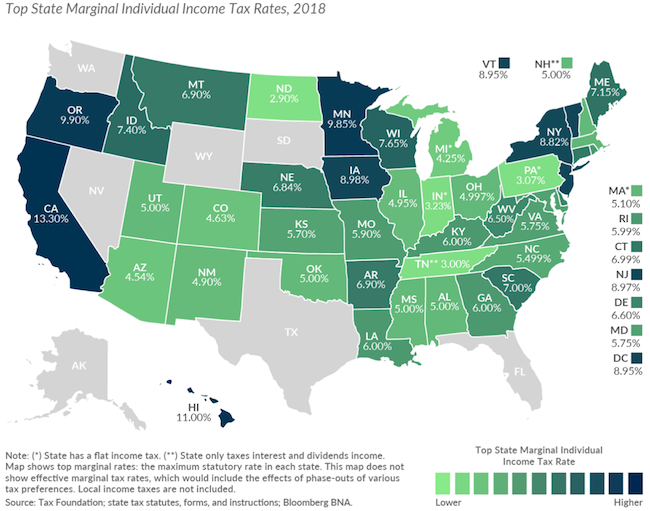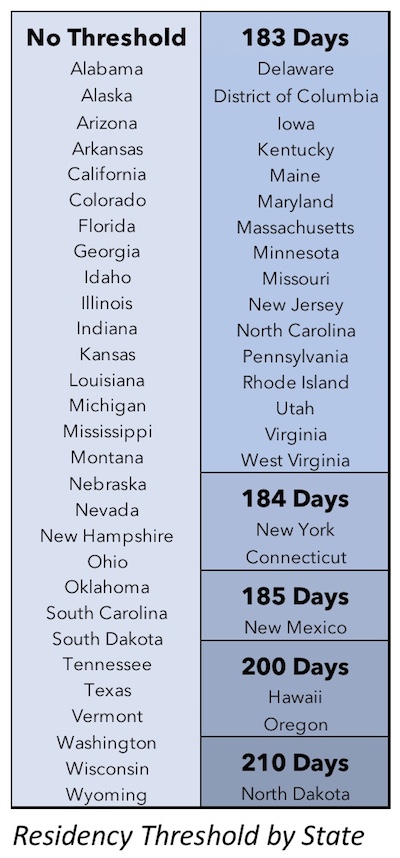Posted on
Let’s face it, nobody likes to pay taxes. So, naturally, everyone tries to pay as little as possible - legally speaking, of course.
And a big part of your taxes, or maybe no part at all, can be your state income tax. Looking at the different laws for each state and determining what you owe can be an interesting yet sometimes frustrating predicament. Let's see why.
Meet Tony, a seasoned exec at an online retailer. Tony had a great 2017 and earned a very nice (and convenient for this blog) salary of $1,000,000. Way to go, Tony! Let’s look at a few state tax scenarios depending on where Tony is a resident.
Imagine if Tony, quite fortunately, lives in one of the 7 states that does not impose a state income tax. If he is a resident of Washington, Nevada, Wyoming, South Dakota, Texas, Alaska or Florida, Tony owes the state a whopping $0.
Alternatively let’s imagine, on the higher side of the possible state taxes, Tony lives out in sunny California, or in a scenic home on the Hudson in New York, or right near his favorite lake in Minnesota. Well, his approximate tax bills would be $108,000 in California, $67,000 in New York, or $93,000 in Minnesota.
That’s a pretty incredible swing in the amount that Tony can end up taking home just based on where he lives. The chart below from TaxFoundation.com shows how your state’s highest tax bracket stacks up against others.[1]

Now, let’s consider a slightly more complicated scenario. Tony has done well during the past few years and now owns a house in Florida, in addition to his house in New York. When he bought his house in Florida, he moved his life down to The Sunshine State. His family and pets are in Florida. He has his car registered and insured in Florida and he has a Florida driver’s license. He votes in Florida. His accountant, doctors, and dentist are in Florida. This is clearly where he is a resident now, right? Well, it depends. Even if Tony has the majority of his life set up in Florida, he can still be a New York resident by simply spending too much time in the state and here’s why.
New York looks at it like this. Tony still owns a house in the state and if he is spending a significant amount of his time in the state (maybe he’s back for work meetings and to see friends and to go to events) then we’d like him to pay New York income tax. Technically, if Tony spends any part of a day in New York then they’ll consider it as a full day, and once he hits 184 days, he’s a New Yorker. The benefit of being a New York resident again? A lovely $67,000 tax bill. And possibly more. It is also dependent on where in the state the house is located but let’s not worry about that now.
Examples like this show why it is so important to know your state’s residency laws. The laws can vary quite a bit from state to state but there are some similarities. For instance, like New York, many states are not only concerned about where you have settled down but also how much time you spend in their state compared to your “home” state. Is there a threshold to be concerned about for one of your residence’s states?

Now that we know this, let’s consider what Tony should do if he owns multiple homes. He should review the state income tax laws in the states where he works or owns a home. If there are rules which could affect his residency status, he should make sure he fully understands how they work and what effect they may have. With that information at the ready, Tony should plan his year to prepare for his projected tax scenario and take precautions to monitor his yearly progress compared to his plan. There is nothing worse than being hit with a bill that you are not prepared for, especially when it can be this significant.
Everyone’s tax situation is unique and our story about Tony is meant to provide a simplified example and should not be used as a guide for your tax situation. You should review your state(s) income tax laws and consult with an accountant to ensure you fully understand your own situation. As a reference, TurboTax has conveniently tracked down all of the contact pages for each state’s Department of Revenue which you can find here.
Questions, comments, feedback? Please contact jared@ware2now.com.
[1] Scarboro, Morgan. “State Individual Income Tax Rates and Brackets for 2018.” Tax Foundation, Tax Foundation, 19 Apr. 2018, taxfoundation.org/state-individual-income-tax-rates-brackets-2018/.
Sign up for email updates, notifications on new blog posts, and local events.
Subscribe

